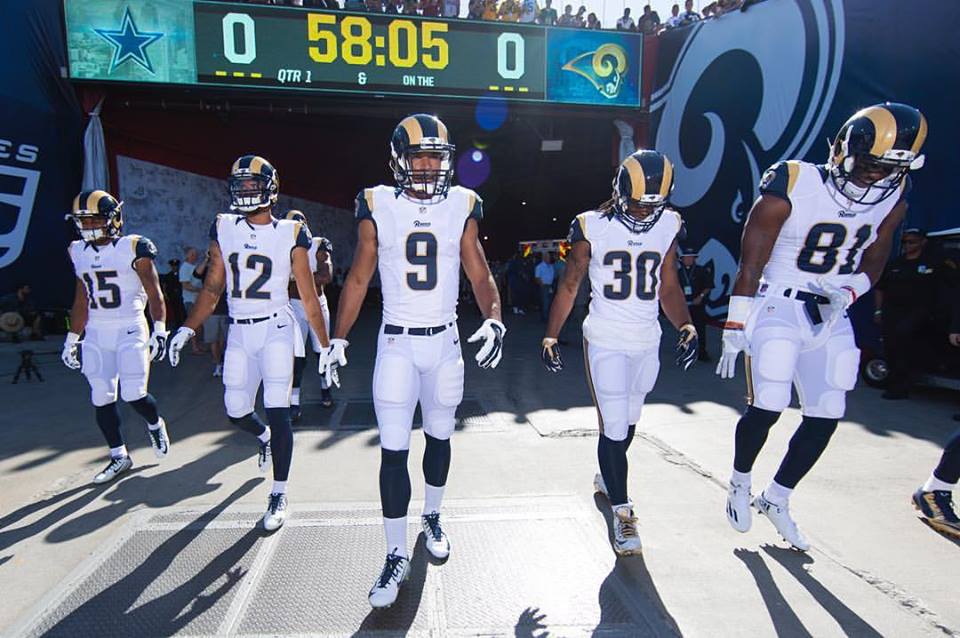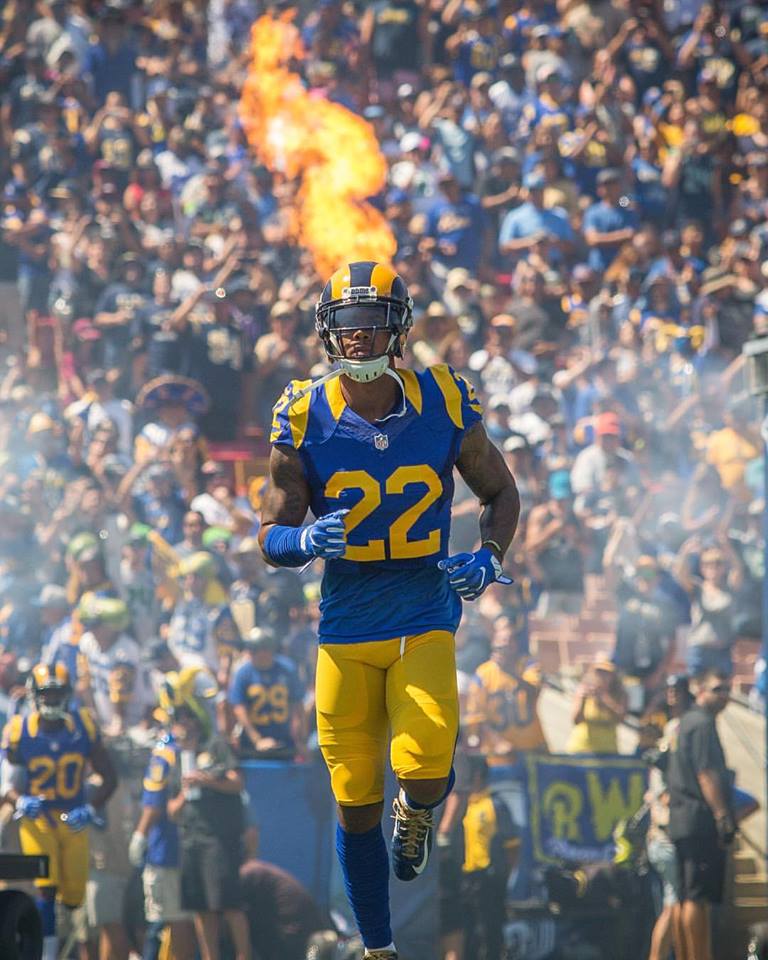Imagine if a historic franchise like the Chicago Cubs, in their clean white, blue, and red uniforms, were to relocate. An idea takes hold to modernize their uniforms and sharpen their identity in their new digs – darken the blue, make that red a touch more metallic. And then, about two decades after the initial move, they reverse course and returned to the Second City, becoming the Chicago Cubs once more, playing in Wrigley Field, ready to reconnect to their roots. But the look is wrong. They wear jerseys that belonged to that other city, not Chicago’s bright blues and reds. Are they still Chicago’s Cubs?
The Cleveland Rams moved to Los Angeles to begin the 1946 National Football League season. In 1948, they notably became the first NFL team to feature a helmet design, thanks to Fred Gehrke‘s spiraling hand-painted yellow horn. In 1950, following a one-year experiment with red and gold, they switched their colors back to royal blue and yellow. It was a scheme they kept through 1963, and (after showcasing a blue/white combination for nearly a decade) from 1973 until they packed their bags in the mid-1990s and moved to the Midwest.
The St. Louis Rams, as they introduced themselves in 1995, may have had new home turf but still featured young running back Jerome Bettis and still wore the same ensemble: royal blue jerseys with confident yellow lettering, the yellow encircling of the horn for each shoulder, yellow pants with blue and white piping, and Gehrke’s familiar design still decorating each helmet, a yellow horn winding inward on a blue background.
They maintained this look through 1996, when they slumped to 6-10; 1997, when they finished a struggling 5-11; 1998, when they sank to 4-12; and 1999, when they posted a shocking 13-3 record behind 28-year-old revelation Kurt Warner at quarterback and “The Greatest Show on Turf” offense, piling up 526 total points and climaxing the season with a dramatic 23-16 victory in Super Bowl XXXIV over Tennessee, the franchise’s first league championship since 1951. It was the first year of a meteoric three-season period for the Rams as a new NFL superpower; it also was the last year of royal blue and yellow.
The St. Louis Rams greeted the Y2K season by introducing a deeper tint of blue, “new century blue,” paired with “millennium gold,” a dollop of spicy brown mustard. (The colors are described in the NFL bylaws as “navy” and “metallic gold.”) The Rams wore the new duds for the next 16 seasons in the Gateway City, capturing the NFC West division title in 2003 but struggling to .500 or worse records in every season thereafter.
On January 4th, 2016, the St. Louis Rams officially filed paperwork to return to Los Angeles. On January 13th, 30 of 32 owners approved the move (and gave the San Diego Chargers the okay as well). A new stadium site was determined in Inglewood, while the Los Angeles Memorial Coliseum, their old home from decades long past, agreed to host them until the new facility was ready. All that was old was new again – except for their wardrobe. The St. Louis makeover remained.
We return you now to the hypothetical situation, already in progress. To the fans of Los Angeles, at last receiving an NFL homecoming, are these their beloved Los Angeles Rams, back home again in the Coliseum? Or are they the St. Louis Rams in a new locale, vaguely familiar yet offputting? “Uniforms,” wrote Gary Klein succinctly in the Los Angeles Times on September 15th, “have been a popular topic of conversation among fans since January when the NFL approved the Rams’ move….”
Rams executive vice president of football operations Kevin Demoff weighed in on the issue in an interview with Klein in March , opining, “I don’t particularly love our current uniforms – I know there are a lot of fans who feel that way.”
The obstacle for the Rams in returning to their Los Angeles color scheme is Section 19.9(D) in the NFL bylaws, which states that a team “must give written notice and details thereof to the League on or before March 1 of the year prior to the year in which it wishes to change; must comply with the uniform change notification and approval timeline as established by the League office and amended from time to time; and further must obtain approval from the League… by December 1 of the year prior to the year in which it wishes to change”.
To go through the process takes forethought, time, and patience. St. Louis’s adjustment to new century blue and millennium gold, for instance, was proposed prior to the previous season’s run to the Super Bowl.
This year’s offseason window, occupied by the logistics required to move the franchise to Los Angeles and negotiate a site to build the new stadium, did not see the Rams act, thereby locking them into their new century blue and millennium gold for the next two seasons at the least, though Gary Klein did report that the owners had met on the issue of reverting the Rams’ colors. He added, “Demoff said the team would not apply for a change until 2017, putting it on track for implementation in 2019”.
2019 is the same year the Rams plan to move into their new stadium in Inglewood, which, despite being in its infant stages, has already been announced as the host of Super Bowl LV in 2021.
The league’s bylaws may have constrained the Rams to continue their St. Louis look as their main uniform, but the NFL doesallow teams to wear throwback jerseys a maximum of two games during the regular season. Opportunity seized, there they were in their first regular season game back in Los Angeles, the September 18th home opener against powerful Seattle, suited back up in their familiar bold blue and yellow from decades past. The result was a stirring 9-3 victory, the first of three consecutive wins following a season-opening defeat.
Yes, came the prompt answer with royal certainty. Though they may only look the part for two of their 16 regular-season home games back in the City of Angels, these are Los Angeles’s Rams.
Images courtesy of the Los Angeles Rams.
This article first appeared in the weekly Football Stadium Digest newsletter. Are you a subscriber? It’s free, and you’ll see features like this before they appear on the Web. Go here to subscribe to the Football Stadium Digest newsletter.


